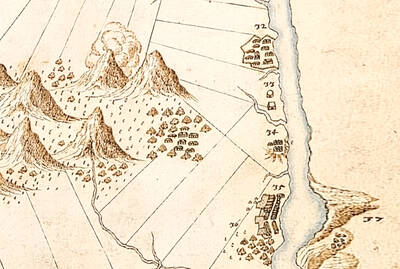IN 2002 Thomas Hertog received an e-mail summoning him to the office of his mentor Stephen Hawking. The young researcher rushed to Hawking’s room at Cambridge. “His eyes were radiant with excitement,” Hertog recalls.
Typing on the computer-controlled voice system that allowed the cosmologist to communicate, Hawking announced: “I have changed my mind. My book, A Brief History of Time, is written from the wrong perspective.”
Thus one of the biggest-selling scientific books in publishing history, with worldwide sales credited at more than 10 million, was consigned to the waste bin by its own author. Hawking and Hertog then began working on a new way to encapsulate their latest thinking about the universe.

Photo: AP
Next month, five years after Hawking’s death, that book — On the Origin of Time: Stephen Hawking’s final theory — will be published in the UK. Hertog will outline its origins and themes at a Cambridge festival lecture on March 31.
“The problem for Hawking was his struggle to understand how the universe could have created conditions so perfectly hospitable to life,” says Hertog, a cosmologist currently based at KU Leuven University in Belgium.
Examples of these life-supporting conditions include the delicate balance that exists between particle forces that allow chemistry and complex molecules to exist. In addition, the fact there are only three dimensions of space permits stable solar systems to evolve and provide homes for living creatures. Without these properties, the universe would probably not have produced life as we know it, it is argued by some cosmologists.

Photo: EPA-EFE
Hertog and Hawking were set on hammering out explanations for this state of stellar uncertainty after the latter had decided his previous attempts were inadequate.
“Stephen told me he now thought he had been wrong and so he and I worked, shoulder to shoulder, for the next 20 years to develop a new theory of the cosmos, one that could better account for the emergence of life,” Hertog said.
It was a remarkable collaboration but not an easy one. When he was 21, Hawking had been diagnosed with an early onset slow-progressing form of motor neurone disease that gradually paralyzed him.
By the time he began working with Hertog, he had been appointed Lucasian professor of mathematics at Cambridge University, one of the world’s most prestigious academic posts (Isaac Newton was a previous holder), and had produced a series of remarkable theories about general relativity, black holes and the origin of the universe as well as his bestseller A Brief History of Time. However, his condition had deteriorated. He was in a wheelchair and could only communicate using a small computer from which he selected words delivered by a speech synthesizer.
“Halfway through our collaboration, he lost the remaining strength in his hand to press the clicker which he used to converse,” says Hertog. So Hawking switched to a sensor mounted on his glasses that could be activated by twitching a cheek muscle, but eventually even that become too difficult.
He slowed from a few words per minute to several minutes per word, Hertog said. In the end, communication stopped.
“I used to position myself in front of him and fire questions and would look into his eyes to see if he was agreeing or disagreeing. By the end, I could detect several levels of no and several levels of yes with a few in between.”
It was out of these “conversations” that Hawking’s final theory was born and, in conjunction with Hertog’s own analysis, they form the basis of On the Origin of Time, a book that takes its title from Charles Darwin’s On the Origin of Species.
“In the end, we both came to think of physics in a way much more like how we think of biology. We have put physics and biology on the same footing.”
According to Hertog, On the Origin of Time deals with questions about our place in the universe and what makes our universe fit for life. These questions were always in the background in their scientific publications.
“What I have done for this book is to make these questions central and tell our story from that perspective. Stephen and I discovered how physics itself can disappear back into the big bang. Not the laws as such but their capacity to change has the final word in our theory. This sheds a new light on what cosmology is ultimately about.”
According to Hertog, the new perspective that he has achieved with Hawking reverses the hierarchy between laws and reality in physics and is “profoundly Darwinian” in spirit.
“It leads to a new philosophy of physics that rejects the idea that the universe is a machine governed by unconditional laws with a prior existence, and replaces it with a view of the universe as a kind of self-organizing entity in which all sorts of emergent patterns appear, the most general of which we call the laws of physics.”

Last week gave us the droll little comedy of People’s Republic of China’s (PRC) consul general in Osaka posting a threat on X in response to Japanese Prime Minister Sanae Takaichi saying to the Diet that a Chinese attack on Taiwan may be an “existential threat” to Japan. That would allow Japanese Self Defence Forces to respond militarily. The PRC representative then said that if a “filthy neck sticks itself in uninvited, we will cut it off without a moment’s hesitation. Are you prepared for that?” This was widely, and probably deliberately, construed as a threat to behead Takaichi, though it

Nov. 17 to Nov. 23 When Kanori Ino surveyed Taipei’s Indigenous settlements in 1896, he found a culture that was fading. Although there was still a “clear line of distinction” between the Ketagalan people and the neighboring Han settlers that had been arriving over the previous 200 years, the former had largely adopted the customs and language of the latter. “Fortunately, some elders still remember their past customs and language. But if we do not hurry and record them now, future researchers will have nothing left but to weep amid the ruins of Indigenous settlements,” he wrote in the Journal of

Even after years in business, weekend tables here can be booked out a month in advance. The price point far exceeds its competitors. Granted, expectations are soaringly high, but something here failed to hit the high notes. There are a few telltale signs that a restaurant relies solely on outstanding food to create the experience, no gimmicks or distractions needed. La Mole is such a restaurant. The atmosphere is food-forward, with an open kitchen center stage. Our tables are simple; no candles, no dim lighting, no ambient music. The menu is brief, and our waiter directs most

Seven hundred job applications. One interview. Marco Mascaro arrived in Taiwan last year with a PhD in engineering physics and years of experience at a European research center. He thought his Gold Card would guarantee him a foothold in Taiwan’s job market. “It’s marketed as if Taiwan really needs you,” the 33-year-old Italian says. “The reality is that companies here don’t really need us.” The Employment Gold Card was designed to fix Taiwan’s labor shortage by offering foreign professionals a combined resident visa and open work permit valid for three years. But for many, like Mascaro, the welcome mat ends at the door. A